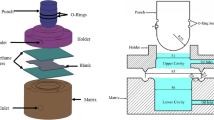Abstract
Forming limit diagram (FLD) is a useful criterion for damage prediction, but not suitable for complex operations. Hooputra’s ductile damage (HDD) is a proper failure criterion which relies on three relatively difficult experimental tests for each material. In this paper, first, using the FLD criterion, the required difficult experimental tests of HDD criterion are simulated and the HDD parameters for St14 steel are numerically estimated. Then, to evaluate the obtained HDD parameters, damage behavior of the material in a number of benchmark tests is numerically predicted, employing the HDD criterion. Finally, the simulated results are compared with the practical observations and the identified HDD parameters are validated. Comparison of the results reveals the HDD parameters can be numerically and properly extracted, utilizing the FLD and avoiding the difficult experimental tests.
Similar content being viewed by others
References
Kachanov LM (1958) On the creep fracture time. Izv Akad Nauk USSR Otd Tekh 8:26–31
Rice JR, Tracey DM (1969) On ductile enlargement of triaxial stress field. J Mech Phys Solids 17:201–217
Hancock JW, Mackenzie AC (1976) On the mechanisms of ductile failure in high-strength steels subjected to multi-axial stress-states. J Mech Phys Solids 24:147–169
Johnson GR, Cook WH (1985) Fracture characteristics of three metals subjected to various strains, strain rates, temperatures and pressures. J Eng Fract Mech 21:31–48
Lemaitre J (1985) How to use damage mechanics. Nuclear Engineering Design 80:233–245
Chaboche JL (1988) Continuum damage mechanics. Part I: general concepts; and Part II: damage growth, crack initiation and crack growth. J Appl Mech 55:59–72
Lemaitre J (1992) A course on damage mechanics. Springer, Berlin
Bao Y, Wierzbicki T (2004) A comparative study on various ductile crack formation criteria. J Eng Mater Technol 126:314–324
Wierzbicki T, Bao Y, Lee Y, Bai Y (2005) Calibration and evaluation of seven fracture models. Int J Mech Sci 47:719–743
Zimniak Z (2000) Implementation of forming limit stress diagram in FEM simulations. J Mater Process Technol 106:261–266
Evangelista SH, Lirani J, Al-Qureshi HA (2002) Implementing a modified Marciniak-Kuczynski model using the finite element method for the simulation of sheet metal deep drawing. J Mater Process Technol 130–131:135–144
Samuel M (2004) Numerical and experimental investigations of forming limit diagrams in metals sheet. J Mater Process Technol 153–154:424–431
Yu Z, Lin Z, Zhao Y (2007) Evaluation of fracture limit in automotive aluminium alloy sheet forming. Mater Des 28:203–207
Hossford WF, Caddell RM (1983) Metal forming mechanics and metallurgy. Prentice-hall press, Englewood cliffs
Hooputra H, Gese H, Dell H, Werner H (2004) Comprehensive failure model for crashworthiness simulation of aluminium extrusions. Int J Crash 9:449–463
Zadpoor AA, Sinke J, Benedictus R (2009) Formability prediction of high strength aluminium sheets. Int J Plast 25:2269–2297
Allahbakhsh HR, Saemi J, Hourali M (2011) Design optimization of square aluminum damage columns with crashworthiness criteria. Mechanika 17:187–192
Dadrasi A (2012) An investigation on crashworthiness design of aluminum columns with damage criteria. Res J Recent Sci 1:19–24
Adewole KK, Race JM, Bull SJ (2013) Identification of micromechanical fracture model for predicting fracture performance of steel wires for civil engineering applications. Int J Civ Archit Struct Constr Eng 7:150–153
Marzbanrad J, Keshavarzi A, Haji Aboutalebi F (2014) Influence of elastic and plastic support on the energy absorption of the extruded aluminium tube using ductile failure criterion. Int J Crashworthiness 19:172–181
Kolmogorov, WL. (1970) Spannungen Deformationen Bruch. Metallurgija. pp. 230–235.
Hill MR, Panontin TL (2002) Micromechanical modeling of fracture initiation in 7050 aluminum. Eng Fract Mech 69:2163–2186
(1986) DIN 1623, Steel flat products cold reduced sheet and strip–technical delivery conditions—general purpose structural steels. Springer, Berlin
(2007) DIN 1623, Cold reduced sheet and strip–technical delivery conditions—general structural steels draft standard. Springer, Berlin
Haji Aboutalebi F, Farzin M, Poursina M (2011) Numerical simulation and experimental validation of a ductile damage model for DIN 1623 St14 steel. Int J Adv Manuf Technol 53:157–165
Haji Aboutalebi F, Farzin M, Mashayekhi M (2012) Numerical predictions and experimental validations of ductile damage evolution in sheet metal forming processes. Acta Mech Solida Sinica 25:638–650
Takuda H, Mori K, Fujimoto H, Hatta N (1999) Prediction of forming limits in bore-expanding of sheet metals using ductile fracture criterion. J Mater Process Technol 92–93:433–438
Author information
Authors and Affiliations
Corresponding author
Rights and permissions
About this article
Cite this article
Haji Aboutalebi, F., Banihashemi, A. Numerical estimation and practical validation of Hooputra’s ductile damage parameters. Int J Adv Manuf Technol 75, 1701–1710 (2014). https://doi.org/10.1007/s00170-014-6275-8
Received:
Accepted:
Published:
Issue Date:
DOI: https://doi.org/10.1007/s00170-014-6275-8




